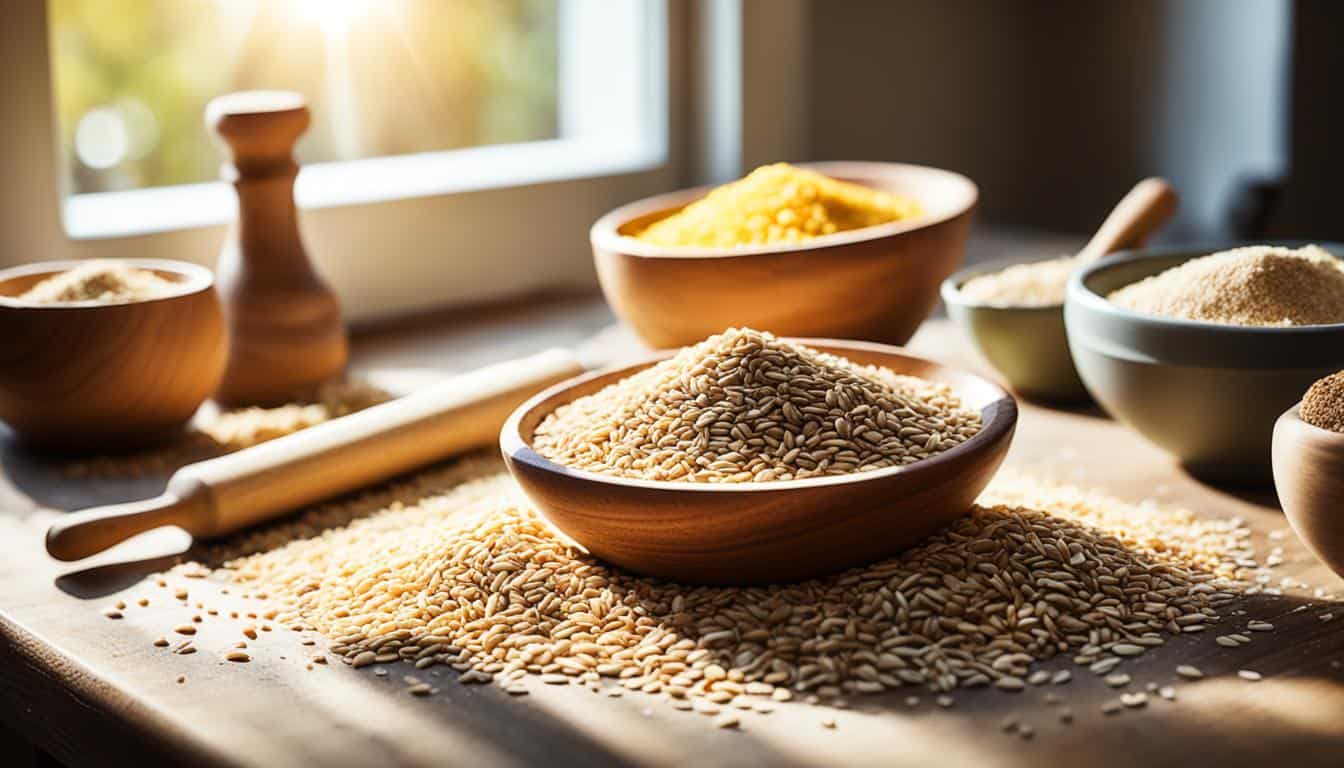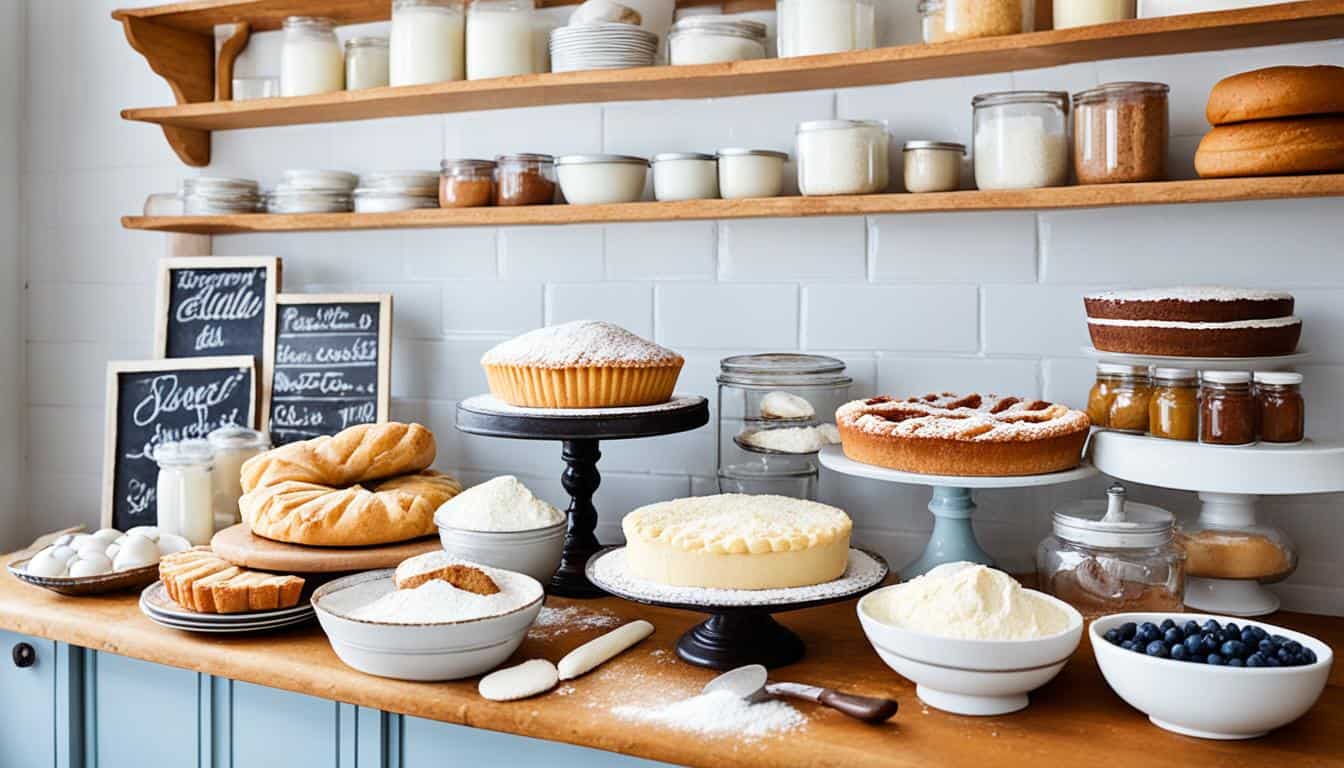Meringue adds a special touch to many desserts. It’s light and sweet, perfect for topping pies or making cookies. Getting it right can seem hard, but don’t worry. With some expert tips, you can make meringue easily. Your desserts will be so fluffy and light, everyone will be amazed.
Once, I was making a French meringue pavlova for a party. I forgot to warm the eggs before using them. So, I separated the yolks and whites, then let the whites sit for 10 minutes. To my surprise, the meringue turned out perfect, even without warm eggs.
Now, let’s talk about what you need for great meringue. You’ll need the right ingredients and tools to impress dessert lovers.
Key Takeaways:
- Room-temperature egg whites beat to a greater volume than those taken directly from the refrigerator.
- Use a large bowl made of copper, stainless steel, or glass for best results.
- Prevent beading by not overbaking the meringue and ensuring all sugar is completely dissolved in the mixture.
- For mini desserts, spoon the meringue into dollops on a baking sheet lined with foil and brown using the broiler or kitchen torch.
Ingredients and Equipment for Making Meringue
To make light and fluffy meringue desserts, you’ll need some key ingredients and tools. Let’s go over what you’ll need.
Meringue Ingredients
The main ingredients for making meringue are:
- Eggs: Use fresh eggs for the best results. Boxed or carton egg whites might change the texture of your meringue.
- Sugar: Granulated sugar is the go-to choice for meringue recipes.
- Cream of Tartar: This ingredient is vital for stabilizing egg whites and making smooth meringue. Use ⅛ teaspoon for every egg white in the recipe.
- Salt: A little salt can boost the flavors in meringue desserts.
- Vanilla Extract: Adding a bit of vanilla extract gives your meringue a delightful flavor.
If you’re out of cream of tartar, you can swap it with ½ teaspoon of lemon juice per egg white. This substitute also stabilizes the egg whites effectively.
Equipment for Making Meringue
Here are the must-have tools for making perfect meringue:
- Bowl and Utensils: Use a clean, dry bowl and utensils to avoid any issues with making meringue.
- Mixer: A stand mixer is best for making meringue, but you can also use a hand mixer or a whisk if needed.
Choose your equipment wisely, making sure everything is clean and dry before starting. Keeping things clean is key to avoiding fat residue that can stop the egg whites from forming stiff peaks.

Step-by-Step Instructions for Making Meringue
Making meringue is a fun process that’s easy to follow. Here are the steps to make light and fluffy meringue for your desserts.
- First, gather your ingredients: egg whites, confectioner’s sugar, cream of tartar, and vanilla extract. Make sure your mixing bowl and beaters are clean and free of grease for the best results.
- Beat the egg whites on medium-high speed until they start to froth. This should only take about a minute.
- Then, add 1/4 teaspoon of cream of tartar for every 2 egg whites to keep the meringue stable. Keep beating until you see soft peaks.
- Slowly add the sugar, a bit at a time, while beating. This helps the meringue hold its shape and gives it a stable texture.
- After adding all the sugar, beat the mixture on high speed until it forms stiff and shiny peaks. The meringue should look smooth, glossy, and hold its shape when you lift the beaters.
- You can add flavors or ingredients like mini chocolate chips, lavender, rose petals, or freeze-dried strawberries at this point. Just fold them in gently to keep the meringue light.
- Put the meringue into a pastry bag with a tip you like for piping shapes, or just drop spoonfuls onto baking sheets.
- Heat your oven to 200 degrees Fahrenheit (95 degrees Celsius) and bake the meringue for about 1.5 hours until it’s dry and crisp. A tip: Keep the meringue in the oven with the door a bit open for an extra hour to get the crispiest results.
- Let the meringues cool completely on the baking sheets before moving them to a wire rack. They can be stored in an airtight container in a cool, dry spot for up to a week.
By following these steps, you can make perfect meringue with a light, airy texture and a crunchy or chewy center. Try different flavors and shapes to add your own twist to these tasty treats.

Tips and Troubleshooting for Making Meringue
Making perfect meringue can be tricky, but with some tips and tricks, you can get it right every time. Here are some helpful tips and advice to make your meringue desserts light, fluffy, and delicious.
- Start with room temperature eggs: Let your egg whites warm up before making meringue. This helps them whip up to their fullest volume.
- Use clean utensils and a clean bowl: Fat residue can stop meringue from reaching stiff peaks. So, make sure your equipment is clean and free of grease.
- Add sugar gradually: Add sugar in two stages. Start with half the sugar while mixing, adding a tablespoon at a time. Then, gently fold in the rest with a spatula.
- Consider adding a mild acid: Adding a bit of cream of tartar or lemon juice can help your meringue. Use about 1/4 teaspoon of cream of tartar for every two to three egg whites.
- Don’t overbeat: Be careful not to beat your egg whites too much. This can make them grainy and hard to get stiff peaks. Stop when they’re glossy and firm, but don’t overdo it.
- Watch out for humidity: Humidity can affect meringue. Try to make it on a day with low humidity if you can.
- Piping techniques: When piping meringue, keep your piping bag straight and about an inch from the baking sheet. Don’t squeeze the bag too hard, or the meringue might deflate.
- Adjust oven temperature if needed: If you see condensation on the meringue while it’s baking, your oven might be too low. Adjust the temperature and time as needed.
These tips will help you fix any problems with meringue and make sure your desserts turn out light and airy. Now, let your creativity shine by adding flavors and colors to your meringue. Try different extracts or food coloring for a unique treat.

Conclusion
Making meringue is an art that needs precision, technique, and patience. We’ve looked at different types of meringue in this article. From the soft French meringue for pies and mousses to the strong Italian meringue for charlottes and bavarois. We also covered the dense Swiss meringue, great for crisp cake layers and pie toppings.
It’s important to know the science behind making meringue. Egg whites have proteins that change when heated. Whisking them well adds air and makes the meringue light and fluffy.
Choosing the right ingredients and steps is key to making great meringue. Sugar is crucial for the right texture, but how and when you add it matters. Adding cream of tartar helps prevent protein over-bonding. And remember, fat can ruin the texture.
In conclusion, making meringue is a fun culinary adventure with many possibilities. With knowledge of meringue types, egg white proteins, and the right techniques, you can make desserts that are light and fluffy. So, get ready, grab your whisk, and let your creativity fly as you start making meringue!


